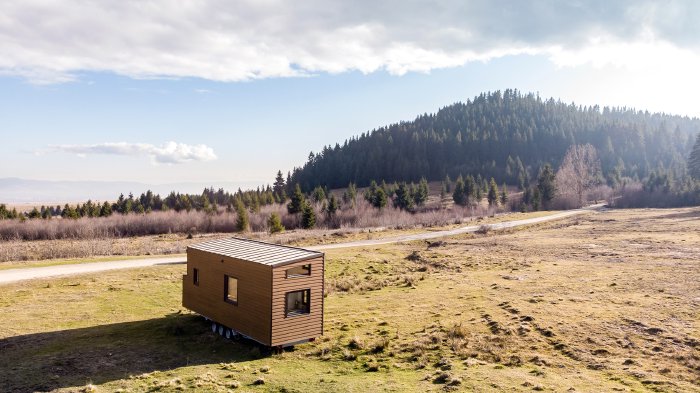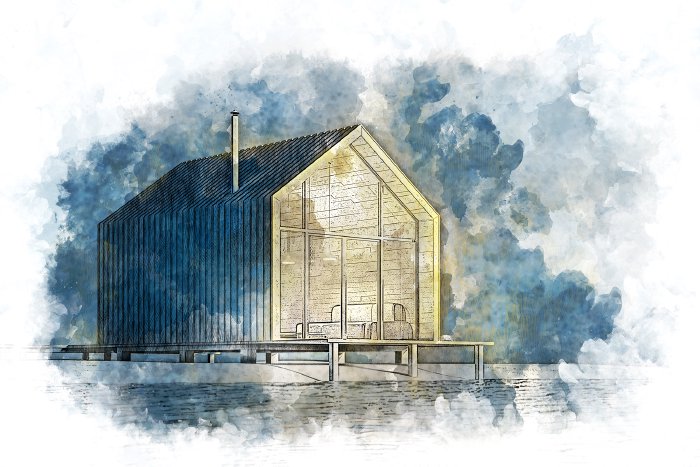You’ve likely seen the shows on TV or maybe watched a few YouTube videos where people decide to “go tiny,” but what does that really mean?
A tiny house is a fully functioning home with a living room, kitchen, bathroom, and sleeping area that is usually below 1,000 square feet (93 m2) in total. However, some tiny houses go as small as 400 square feet (37 m2) and are small enough to be towed behind a car or truck.
If you’re looking into going tiny, you’ve come to the right place! In this article, I’ll go over some of the basics of tiny living so you’ll know what to expect.

How Is a Tiny House Different From a Regular House?
A tiny house is different from a regular house in that it has all of the basic essentials, such as a kitchen and sleeping space, but none of the “dead space” a traditional house has. Tiny homes typically give enough room for one or two people to live comfortably without too many possessions.
Dead space in a home can be defined as hallways and entryways, extra living areas, or a dining room when you already have a kitchen table and chairs.
The idea behind tiny houses is that they give the owner everything they need and nothing more.
What’s the Difference Between a Tiny House and a Trailer?
The main difference between a tiny house and a trailer is the quality of the build. Trailers (mobile homes) are often built from lower-quality materials, such as aluminum, and have little to no insulation. In contrast, tiny houses are usually made to a higher standard.
It’s easy to see why people would make comparisons to tiny houses and trailers. In the States, especially, many tiny homes are built on wheels, allowing their owner to move them around at their leisure.
Finding places to park these tiny homes can be difficult, and as such, many “tiny house communities” are popping up all over. It’s not uncommon to pull into a trailer park and see several tiny homes lined up.

In essence, tiny homes are a lot like trailers; they just tend to be built better.
Here are a few differences between tiny houses and trailers (mobile homes):
Materials
- Tiny houses are usually built out of wood and have plenty of insulation, just like a regular house.
- Mobile homes are often steel structures with aluminum panels and thin (if any) insulation.
Mobility
- When built to fit a trailer, tiny houses are very mobile and fit in a grey area in terms of permits and planning permissions.
- Mobile homes are less mobile (ironically), and they aren’t designed to be moved.
Size
- The average tiny house is 8 feet (2.44 m) wide and 26 feet (7.92 m) long.
- The average mobile home is 14 feet (4.27 m) wide and 40 feet (12.19 m) long.
Speed of Build
- Due to the intricacies of fitting so much in a small space, most tiny homes take at minimum, 120 hours to build.
- Mobile homes are factory built and usually ready to ship in weeks.
The Look
- Tiny homes are very versatile and can be made to your own personal design and style.
- Mobile homes are mostly the same, with very little room to be creative.
What’s the Biggest a Tiny House Can Be?
The biggest a tiny house can be is between 400 and 1,000 square feet (37 - 93 m2), with the majority sitting under 400 square feet. However, there are no rules that say you have to stay below a specific number, unless you will be building on a trailer.
If you choose to build your tiny on a trailer, you will need to keep within the size of the frame.
The average American home is around 241.55 m2 (2,600 square feet). In contrast, European homes are typically smaller, for example:
- United Kingdom average: 76 m2 (818.06 square feet)
- France average: 112 m2 (1205.56 square feet)
- Germany average: 109 m2 (1173.27 square feet)
- Sweden average: 83 m2 (893.41 square feet)
It’s safe to assume that the smaller number in the UK is down to London and the number of flats/apartments available.
Sweden, too, is full of smaller apartments in and around its capital, Stockholm, that no doubt reduced their overall average.
In the States, they have more space. So, even with New York City being full of small apartments, the number of mansions and ranch houses across states like Texas keeps their country average relatively high.
With that in mind, going tiny for Europeans may be more accessible due to the fact they already live in smaller spaces.

Tiny House Sizes in the United States
Since many people choose to build their tiny homes on wheels, it is important to consider state and national guidelines before you get started.
If you want to move your tiny house in the States without getting a permit, it can be no bigger than:
- 13.5-feet tall (4.12 m)
- 8.5-feet wide (2.59 m)
- 40-feet long (12.19 m)
- 65-feet at most which includes the towing car or truck (19.81 m)
Anything larger than this, and you would need a special permit.
Tiny House Sizes in Europe
Given the size of Europe and the varying rules by country, there are no set guidelines you can check for a “European” tiny house.
Instead, you’ll need to check your country for their guidelines and those of any country you think you may want to visit.
But it’s not going to be easy.
Some European countries don’t have rules regarding tiny houses specifically, which can make it hard to find what you’re looking for.
That said, here are a few rules to keep in mind:
- In the UK, your tiny home can be no wider than 2.55 m (8.37 feet) in order to be road legal, and no more than 7 m (22.97 feet) in length if you have a standard driver’s license.
- In France, your tiny home cannot weigh more than 3.5 metric tons (7,716 pounds).
- In Germany, the law states you must register your place of residence, which means you can’t legally live in your tiny house if it has no fixed address.
- In Denmark, if you park your tiny house in one spot for more than six weeks, it has to be registered and, therefore, is considered a permanent structure that must adhere to building codes.
Is Tiny Living Right For You?
Tiny living is right for you if you think you can live with few possessions and if you don’t need a lot of space to move around. It is best for singles or couples, as families with children may struggle in the limited space.
The truth is, anyone can go tiny. However, it likely won’t be easy, especially if you currently live in a larger space and have a lot of belongings.
That said, if you’re willing to pair down and get rid of anything that isn’t essential, I’m sure that you could make it work.